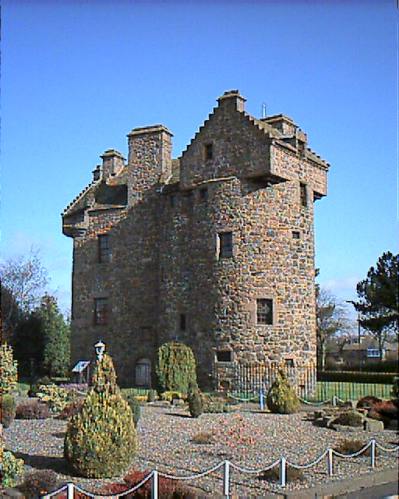Comparing
Broughty and Claypotts Castles
SIMILARITIES
Broughty Castle and Claypotts Castle were built less than a century apart. Both designs demonstrate a need for strong defence, but also for comfortable and spacious accommodation.
Looking at the exteriors of both castles, you can observe several key features they have in common. In terms of defensive features, both structures have thick walls, through which are several gun ports, set low down near the bases of the walls, to deter attackers. Those at Claypotts are part of the original, 16th century design, whereas those at Broughty Castle date from different periods - there are medieval gun ports in the tower, but later gun ports serving a similar purpose, elsewhere in the castle.
Gun ports to the right of the entrance to Broughty Castle |
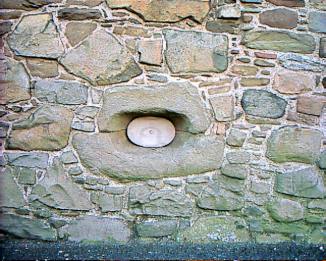 A gun port at Claypotts |
The tower house at Broughty Castle originally had a similar arrangement of rooms to that at Claypotts Castle. Although Broughty Castle has been altered during its long history, its entrance was originally on the ground floor, where there are vaulted storage cellars rather like those at Claypotts.
Like Claypotts, Broughty Castle had a main hall on the first floor, and the floors above it were used as chambers. There was once a fireplace in the main hall at Broughty Castle, large enough to have a small window of its own, but it has been blocked up and is no longer visible. The upper rooms of both castles are lit by windows facing in different directions (although some of the windows in Broughty Castle's tower house are not original, but added by Robert Rowand Anderson in the 1860s).
 |
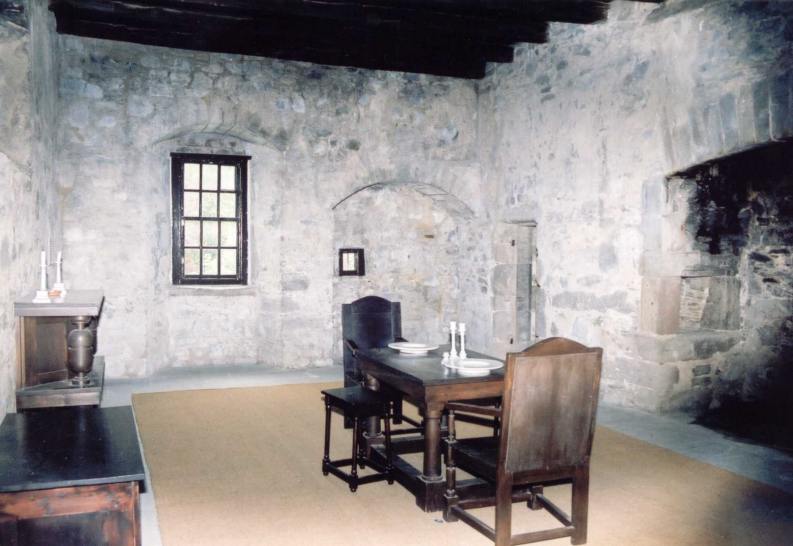 |
The large rooms in both castles have thick walls, with deep recesses for the windows, and heavy, exposed roof beams
Both castles are equipped with spiral stairs, both running in a clockwise direction. Both have a `service stair' leading down to the ground floor (although at Broughty Castle, this is not normally open), so that servants could bring food and other things from the kitchen and cellars to the main hall and chambers above.
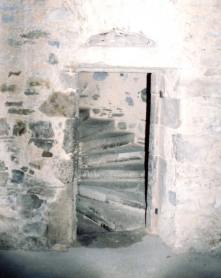
Part of the spiral stairs at Claypotts
There are further similarities in the upper parts of both castles. Both have parapet walkways, enabling the castle's defenders to fire down from the upper part of the tower. At Broughty Castle, the walkway is more complete, and includes crenellations (there are gaps in the stonework through which defenders could fire without the risk of being shot from the ground). Both castles are also equipped with numerous rainwater spouts, projecting outwards from the walls.

This view of Broughty Castle shows its parapet walkway, with rainwater spouts projecting from near its base
Both castles also have a garret. The garret at Claypotts Castle retains its original, 16th-century form, while that at Broughty Castle now houses the armoury displays. Both allowed access to the parapet walkways.
DIFFERENCES
Despite their many similarities, Broughty and Claypotts Castles also have many differences, due to their different histories. The appearance of both castles has changed a great deal since they were built.
At Broughty Castle, there have been many alterations in oder to meet the needs of defence at different times in the castle's history. Of the castle's original courtyard layout there is now little trace, because it has been altered so extensively to make it stronger and to accommodate gun emplacements and ammunition stores. Unfortunately, there is now no trace of the courtyard that once surrounded Claypotts Castle, but it would have contained other buildings such as stores and stables.
Whereas Claypotts Castle ceased to be a residence for its owners around the early 17th century, as was changed little thereafter, Broughty Castle was given a new lease of life as a coastal fortress in the 19th century, and many additions and alterations were made at that time.
A key reason for this is Broughty Castle's strategically important position at the mouth of the River Tay. Not only was this important in medieval times, but it continued to be important in later times, even as recently as the 20th century, when a defence post was added to the castle during World War II. Claypotts Castle, in contrast, had no role as a fortress during recent centuries.
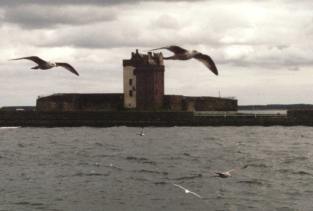
Above: Broughty Castle's strategically important position has been the key to its continued role as a fort
Below: Many of Claypotts Castle's original features survive, partly because it did not have a continuing role as a fort
